Objective: To estimate the risk of cesarean delivery due to excess prepregnancy body mass index (BMI) in a multistate, US population-based sample. Methods: We analyzed data from the population-based Pregnancy Risk Assessment Monitoring System (PRAMS) on 24,423 nulliparous women with single, term infants delivered between 1998 and 2000 in 19 states. We calculated BMI from self-reported weight and height. We assessed interactions between prepregnancy BMI and other risk factors. We estimated weighted relative risks and 95% confidence intervals for the association between prepregnancy BMI and cesarean section from multiple logistic regression models adjusting for demographic and medical risk factors from the PRAMS questionnaire or birth certificates. Results: The incidence of cesarean delivery increased with increased prepregnancy BMI, from 14.3% (0.8 standard error (SE)) for lean women (BMI < 19.8) to 42.6% (2.0 SE) for very obese women (BMI ≥ 35). The risk of cesarean section differed by presence of any medical, labor and/or delivery complication. Among women with any complication, the estimated adjusted RR for cesarean delivery was 1.1 (95% confidence interval (CI) 1.0–1.2) among overweight women, 1.3 (95% CI 1.1–1.4) among obese women, and 1.4 (95% CI 1.2–1.6) among very obese women compared with normal weight women. Among women without any complications, the estimated adjusted RR was 1.4 (95% CI 1.0–1.8) among overweight women, 1.5 (95% CI 1.1–2.1) among obese women, and 3.1 (95% CI 2.3–4.8) among very obese women. Conclusion: Excess prepregnancy weight increases the risk of cesarean delivery among nulliparous women giving birth to single, term infants, especially among very obese women without any complications.
Similar content being viewed by others
REFERENCES
Martin JA, Hamilton BE, Sutton PD, Ventura SJ, Menacker F, Munson ML. Births: Final Data for 2002. National Vital Statistics Reports. Hyattsville, MD: National Center for Health Statistics, 2003, Vol. 52, No. 10.
Flegal KM, Carroll MD, Ogden CL, Johnson CL. Prevalence and trends in obesity among US adults, 1999–2000. JAMA 2002;288:1723–1727.
Kaiser PS, Kirby RS. Obesity as a risk factor for cesarean in a low-risk population. Obstet Gynecol 2001;97:39–43.
Young TK, Woodmansee B. Factors that are associated with cesarean delivery in a large private practice: The importance of prepregnancy body mass index and weight gain. Am J Obstet Gynecol 2002;187:312–320.
Jensen DM, Damm P, Sorensen B, Molsted-Pedersen L, Westergaard JG, Ovesen P, et al. Pregnancy outcome and prepregnancy body mass index in 2459 glucose-tolerant Danish women. Am J Obstet Gynecol 2003;189:239–244.
Witter FR, Caufield LE, Stoltzfus RJ. Influence of maternal anthropometric status and birth weight on the risk of cesarean delivery. Obstet Gynecol 1995;85:947–951.
Brost BC, Goldenberg RL, Mercer BM, Iams JD, Meis PJ, Moawad AH, et al. The Preterm Prediction Study: Association of cesarean section with increases in maternal weight and body mass index. Am J Obstet Gynecol 1997;177:333–341.
Cnattingius R, Cnattinggius S, Notzon FC. Obstacles to reducing cesarean rates in a low-cesarean setting: The effect of maternal age, height, and weight. Obstet Gynecol 1998;92:501–506.
Crane SS, Wojtowycz MA, Dye TD, Aubry RH, Artal R. Association between prepregnancy obesity and the risk of cesarean delivery. Obstet Gynecol 1997;89:213–216.
Cedergren MI. Maternal morbid obesity and the risk of adverse pregnancy outcome. Obstet Gynecol 2004;103:219–224.
Perlow JH, Morgan MA. Massive maternal obesity and perioperative cesarean morbidity. Am J Obstet Gynecol 1994;170:560–565.
Bianco AT, Smilen SW, Davis Y, Lopez A, Lapinski R, Lockwood CJ. Pregnancy outcome and weight gain recommendations for the morbidly obese woman. Obstet Gynecol 1998;91:97–102.
Nuthalapaty FS, Rouse DJ, Owen J. The association of maternal weight with cesarean risk, labor duration, and cervical dilation rate during labor induction. Obstet Gynecol 2004;103:452–456.
Buhimschi CS, Buhimschi I, Malinow AM, Weiner CP. Intrauterine pressure during the second stage of labor in obese women. Obstet Gynecol 2004;103:225–230.
Institute of Medicine. Nutrition during pregnancy. Part I, Weight Gain. Washington, DC: National Academy Press, 1990.
SUDAAN, Release 8.0 [Computer Software], Research, Triangle Park (NC): Research Triangle Institute, 1991.
Hosmer DW, Lemeshow S. Applied Logistic Regression, New York, NY: Wiley, 1989.
Zhang J, Yu KF. What's the relative risk? A method for correcting the odds ratio in cohort studies of common outcomes. JAMA 1998;280:1690–1691.
Efron B, Tibshirani R. An Introduction to the Bootstrap. New York, NY: Chapman & Hall, 1993.
Martin JA, Hamilton BE, Ventura SJ, Menacker F, Park M. Births: Final Data for 2000. National Vital Statistics Reports. Hyattsville, MD: National Center for Health Statistics, 2002, Vol. 50, No. 5.
Lederman SA, Paxton A. Maternal reporting of prepregnancy weight and birth outcome: Consistency and completeness compared with the clinical record. Matern Child Health J 1998;2(2):123–126.
Stevens-Simon C, Roghmann KJ, McAnarney ER. Relationship of self-reported prepregnant weight and weight gain during pregnancy to maternal body habitus and age. J Am Diet Assoc 1992;92:85–87.
DiGiuseppe DL, Aron DC, Random L, Harper DL, Rosenthal GE. Reliability of birth certificate data: A multi-hospital comparison to medical records information. Matern Child Health J 2002;6(3):169–179.
Dobie SA, Baldwin L, Rosenblatt RA, Fordyce MA, Andrilla CH, Hart LG. How well do birth certificates describe the pregnancies they report? The Washington State experience with low-risk pregnancies. Matern Child Health J 1998;2:145–154.
ACKNOWLEDGMENTS
Data from the Pregnancy Risk Assessment Monitoring System (PRAMS) included in this study are collected at the state level by the following state collaborators and their staff: Alabama-Rhonda Stephens, MPH; Alaska-Kathy Perham-Hester, MS, MPH; Arkansas-Gina Redford, MAP; Colorado-Alyson Shupe, PhD; Florida-Helen Marshall; Hawaii-Limin Song, MPH, CHES; Illinois-Theresa Sandidge, MA; Louisiana-Dionka Pierce; Maine-Martha Henson; Nebraska-Jennifer Severe-Oforah, PhD; New Mexico-Ssu Weng, MD, MPH; New York State-Anne Radigan-Garcia; North Carolina-Paul Buescher, PhD; Ohio-Amy Davis; Oklahoma-Dick Lorenz, MS; South Carolina-Mary Kate Powell; Utah-Lois Bloebaum; Washington-Linda Lohdefinck; West Virginia-Melissa Baker, MA; CDC PRAMS Team, Applied Sciences Branch, Division of Reproductive Health.
Author information
Authors and Affiliations
Corresponding author
Rights and permissions
About this article
Cite this article
Dietz, P.M., Callaghan, W.M., Morrow, B. et al. Population-Based Assessment of the Risk of Primary Cesarean Delivery Due to Excess Prepregnancy Weight Among Nulliparous Women Delivering Term Infants. Matern Child Health J 9, 237–244 (2005). https://doi.org/10.1007/s10995-005-0003-9
Published:
Issue Date:
DOI: https://doi.org/10.1007/s10995-005-0003-9




